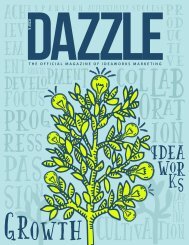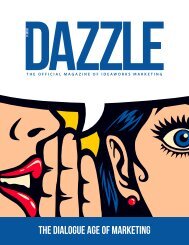Dazzle Issue 6
Create successful ePaper yourself
Turn your PDF publications into a flip-book with our unique Google optimized e-Paper software.
EDITOR’S LETTER<br />
CHELSEY TUPPER, DIRECTOR OF OPERATIONS & CLIENT DEVELOPMENT<br />
At Ideaworks, our<br />
A look at the Award-Winning<br />
2019 Ideaworks calendar<br />
ANNUAL CALENDAR PROJECT<br />
is one that our team takes great pride in<br />
and anticipates each year.<br />
Lately, I’ve been hearing<br />
and reading a lot about<br />
storytelling. The topic is<br />
everywhere — from industry<br />
publications and webinars to<br />
client projects. Much of what<br />
I’ve come to discern about the<br />
art of storytelling is that it is<br />
essential to success — for both<br />
individuals and businesses. This<br />
is because stories help us to<br />
better conceptualize the world<br />
and make sense of the things<br />
around us. Therefore, when an<br />
individual or organization maps<br />
out the story they want to tell,<br />
it can serve as a road map to<br />
help achieve established goals.<br />
Since this might be a slightly<br />
different perspective on<br />
storytelling — and not<br />
what most are traditionally<br />
familiar with — consider this:<br />
when you create a story that<br />
communicates who you are<br />
as a person or business entity,<br />
it illustrates your truth to your<br />
audience. This is important<br />
because your truth is what sets<br />
the foundation for who you<br />
are or what you are striving to<br />
become. As such, your truth<br />
continuously guides you in the<br />
direction you need to go to<br />
achieve success.<br />
At a content marketing<br />
workshop my colleague<br />
and I attended in December<br />
and also during a business<br />
development session I recently<br />
participated in, both presenters<br />
discussed the importance of<br />
organizations establishing<br />
their truths. When a company<br />
knows its truth, it shapes its<br />
story. For example, say your<br />
marketing agency’s truth<br />
is that it always provides<br />
clients with high-level work<br />
that is fresh and creatively<br />
innovative. To manifest that<br />
truth, your team will do all it<br />
can for each project so the<br />
agency story remains accurate.<br />
This is then the story you<br />
weave throughout various<br />
communication channels to<br />
retain and earn the trust of<br />
clients and prospects.<br />
Another example is the<br />
rise of content marketing.<br />
Industry professionals have<br />
embraced content marketing<br />
because it allows brands<br />
to tell their stories over<br />
and over through different<br />
mechanisms that share a<br />
common goal: to connect<br />
with consumers, tailoring the<br />
language to resonate with<br />
them and thereby creating<br />
a more trusting relationship.<br />
Whether it’s a blog post, white<br />
paper or testimonial, the<br />
underlying purpose of each is<br />
to communicate elements of<br />
the brand’s story so consumers<br />
can decide if they’d like to<br />
associate with that particular<br />
entity. That’s why establishing<br />
your truth and crafting a story<br />
around that truth is so critical<br />
to success.<br />
Storytelling works the same<br />
way on a personal level. Think<br />
about those aspects of yourself<br />
that you’d like to improve<br />
upon or enhance. Ask yourself:<br />
Who do I want to become as<br />
a person? What are the things<br />
that matter most to me? What<br />
do I stand for? Discovering the<br />
answers to these questions will<br />
help define your truth.<br />
Once established, your truth will<br />
give you a clearer picture of what<br />
you need to do to “write” a story<br />
you will be proud to tell in the<br />
future. Your truth can also guide<br />
you in how to project yourself to<br />
those with whom you interact.<br />
While most think of storytelling<br />
as merely vocalizing a story, it’s<br />
much more than that. To tell a<br />
truly great story, you must look<br />
at its elements and ensure that<br />
there is an underlying truth<br />
that will benefit the listener or<br />
reader — something that makes<br />
your story memorable. Even<br />
though it’s mid-April, it isn’t<br />
too late to consider what you<br />
would like your story to be for<br />
2019 — whether professionally<br />
or personally. Think about your<br />
truth and create your story<br />
accordingly. Then, the next time<br />
you’re speaking with a business<br />
prospect or interacting with a<br />
personal contact, you’re prepared<br />
to connect with them on a much<br />
more meaningful level.<br />
As such, we begin brainstorming clever ideas well before the<br />
holiday season is upon us. Our imaginations are always put to the<br />
test to top the previous year’s concept, and we don’t settle on an<br />
approach until we are confident that it will surely impress. For this<br />
year’s calendar, we thought it would be fun — and fitting — to<br />
showcase our 12 favorite 2019 logo trends in action by designing a<br />
logo for each trend. This approach not only allowed us to showcase<br />
our creative talent, but to also serve as an educational tool for<br />
fellow marketing professionals.<br />
WINNER OF THREE<br />
2019 ADDY AWARDS:<br />
Judge’s Choice<br />
People’s Choice<br />
Gold<br />
Therefore, I leave you with the following question: What is your story?<br />
4 DAZZLE: ISSUE SIX

















